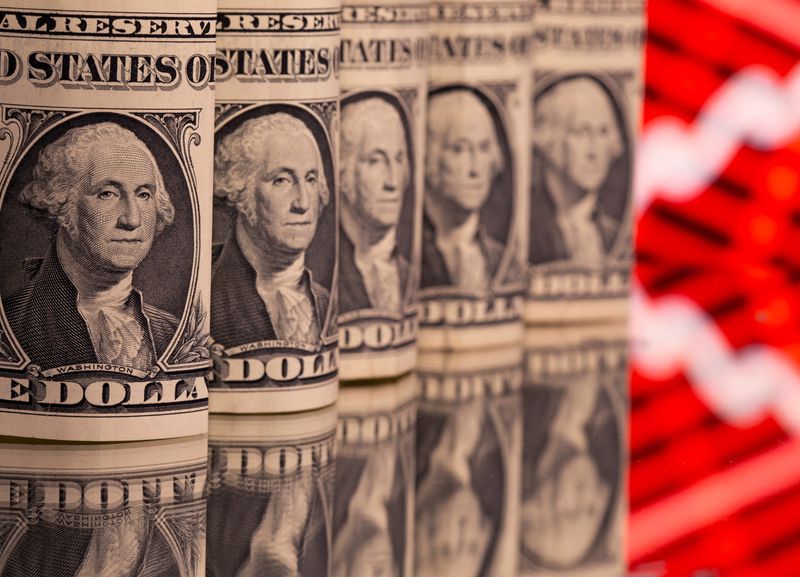Saqib Iqbal Ahmed and Laura Matthews
(Reuters) – The U.S. dollar’s rally is accelerating as stubborn inflation sows doubts about how aggressively the Federal Reserve can cut rates this year compared with other central banks.
The index, which measures the dollar against a basket of six major currencies, has risen 4.6% this year and is near its highest level since early November. The index rose 1.7% last week, its biggest weekly gain since September 2022.
The dollar is rising as market participants become increasingly convinced the Fed will have to keep interest rates at current levels for longer to avoid a potential resurgence of inflation. Stronger-than-expected consumer price data last week supported that view, with investors late Friday forecasting interest rate cuts of just 50 basis points in 2024, futures markets showed, compared with 150 basis points priced in beginning of the year.
In contrast, investors believe some global central banks, including the European Central Bank, the Bank of Canada and Sweden’s Riksbank, could have more leeway to ease monetary policy. That’s a change from a few months ago, when many thought the Fed would be among the first to cut rates.
“We had a pretty good idea that the Fed would probably be the first mover. The data we’ve seen really undermines that,” said Eric Leve, chief investment officer at wealth and investment management firm Bailard. “I see obvious reasons why the dollar could strengthen further.”
Yield differentials between the U.S. and other economies have widened in recent weeks, boosting the dollar as higher yields make dollar assets more attractive. The two-year U.S.-German bond spread hit its widest since 2022 late Friday, LSEG data showed, a day after the European Central Bank signaled it could cut rates as soon as June.
Bullish investors increased their bets by the dollar while bears hesitated. Net bets on the dollar in futures markets totaled $17.74 billion in the latest week, the highest level since August 2022, according to the Commodity Futures Trading Commission.
Central bank policies have changed in recent months to reflect economies’ varying efforts to curb inflation.
The Swiss National Bank cut rates by 25 basis points in March, its first cut in nine years. Sweden’s central bank has signaled it could cut rates in May if inflation continues to fall, and the Bank of Canada recently said it was open to rate easing.
On the other hand, the central banks of Australia, the UK and Norway appear less inclined to ease monetary policy.
Meanwhile, the Japanese yen fell to a near 34-year low against the dollar, although the country recently ended eight years of negative interest rates. The Bank of Japan ruled out raising rates to support the currency.
Eric Merlis, managing director and co-head of global markets at Citizens, said the dollar could continue to strengthen broadly amid a more aggressive Fed policy toward the ECB. The euro has fallen 3.6% against the US dollar this year.
“The dollar has room to strengthen. We now have the strongest economy, and overall the yield trajectory is going up,” he said. “Whereas Europe is struggling in terms of growth.”
A stronger dollar could make it harder for other economies to fight inflation as it pushes their currencies lower while helping the U.S. lower consumer prices by tightening financial conditions.
Dollar strength can also be a headwind for U.S. multinationals because it makes it more expensive to convert their overseas profits into dollars and makes exporters’ products less competitive abroad.
Other factors can also affect the dollar exchange rate. The US currency is a popular destination for investors in times of geopolitical uncertainty, which has worsened in recent days due to concerns about the widening conflict in the Middle East.
Brian Liebowitz, Chief International Foreign Exchange Dealer Northern Trust (NASDAQ:), believes that the dollar may receive support from the Fed, which will allow assets to deplete its balance sheet. This process is known as quantitative tightening.
The Fed currently allows up to $60 billion per month in Treasuries and up to $35 billion per month in permanently maturing mortgage bonds.
While Northern Trust had expected the dollar to strengthen 5% ahead of the U.S. presidential election, “market activity since the dollar’s initial rally this week suggests the move could come sooner than expected,” Liebowitz said.

Others are less confident that the dollar has more room to move. Scotiabank’s Sean Osborne wrote that the recent strength in the dollar means investors are priced in to a lot of bullish news.
However, rates and spreads favor the dollar, meaning “the trend at the moment suggests the dollar will remain better supported,” he said.


